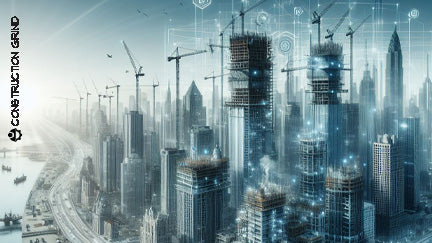
Key Trends Shaping the Future of Construction in the U.S.
Share
The following trends represent the ongoing transformation of the construction industry in the US, driven by technological advancements, sustainability imperatives, resilience challenges, and the need for skilled workforce development and innovative financing models. Embracing these trends can help address current and future challenges while creating more sustainable, resilient, and efficient built environments for communities across the country.
1. Technology Integration:
Building Information Modeling (BIM): BIM is a digital representation of a building's physical and functional characteristics. It allows architects, engineers, and construction professionals to collaborate on a project's design, construction, and operation in a virtual environment.
Drones: Drones, or unmanned aerial vehicles (UAVs), are equipped with cameras and sensors to capture aerial imagery and data of construction sites. They are used for surveying, monitoring progress, inspecting hard-to-reach areas, and enhancing safety.
Augmented Reality (AR) and Virtual Reality (VR): AR overlays digital information onto the real-world environment, while VR immerses users in a simulated environment. Both technologies are used for visualizing building designs, simulating construction processes, and training workers.
Robotics and Automation: Robotics and automation technologies, such as robotic arms, 3D printers, and autonomous vehicles, are increasingly used in construction for tasks like bricklaying, concrete pouring, and site logistics, improving productivity and safety.
2. Sustainability and Green Building:
Renewable Materials: Renewable materials like wood, bamboo, and recycled materials are used in construction to reduce environmental impact and promote sustainability.
Energy-Efficient Design: Buildings are designed with energy-efficient features such as high-performance insulation, LED lighting, and passive solar design to minimize energy consumption and reduce carbon emissions.
Circular Economy Practices: The circular economy approach aims to minimize waste and maximize resource efficiency by reusing, recycling, and repurposing construction materials and components.
Green Building Certifications: Certifications like LEED (Leadership in Energy and Environmental Design) provide standards for sustainable building design, construction, and operation, encouraging developers to adopt environmentally friendly practices.
3. Off-Site Construction and Prefabrication:
Modular Construction: Modular construction involves building components or entire modules off-site in a factory-controlled environment, then transporting and assembling them on-site. This approach reduces construction time, waste, and disruption to local communities.
Prefabricated Components: Prefabricated elements such as walls, floors, and roof trusses are manufactured off-site with precision and then assembled on-site, improving construction quality and efficiency.
Panelized Construction: Panelizing involves assembling building components into panels off-site, which are then transported to the construction site for installation. This method speeds up construction and allows for greater design flexibility.
4. Smart Infrastructure and IoT:
Smart Buildings: IoT (Internet of Things) sensors and systems are embedded in buildings to monitor and control various functions such as lighting, HVAC (heating, ventilation, and air conditioning), security, and occupancy, optimizing energy use and enhancing occupant comfort.
Smart Transportation Systems: Intelligent transportation systems use sensors, cameras, and data analytics to manage traffic flow, improve safety, and provide real-time information to travelers, reducing congestion and enhancing mobility.
Smart Cities: Smart city initiatives leverage technology and data to enhance urban services such as energy distribution, waste management, public safety, and governance, improving quality of life for residents and fostering sustainable development.
5. Resilience and Adaptation to Climate Change:
Climate-Resilient Design: Buildings and infrastructure are designed to withstand the impacts of climate change, such as extreme weather events, sea-level rise, and heatwaves, through measures like flood-resistant design, stormwater management, and resilient materials.
Natural Disaster Preparedness: Infrastructure projects incorporate features such as redundancy, robustness, and flexibility to minimize the risks and impacts of natural disasters such as earthquakes, hurricanes, and wildfires.
6. Workforce Development and Skills Training:
Digital Skills: Construction professionals need to acquire digital skills such as BIM modeling, drone operation, and data analytics to adapt to the technological advancements transforming the industry.
Safety Training: Safety training and awareness programs are essential to mitigate the risks associated with new technologies and construction methods, ensuring the well-being of workers on-site.
Continuing Education: Lifelong learning and professional development opportunities are crucial for construction workers and professionals to stay updated on emerging trends, regulations, and best practices in the industry.
Emphasis on Diversity and Inclusion: The construction industry will place greater emphasis on diversity, equity, and inclusion to attract and retain a diverse workforce. This includes targeted recruitment efforts, mentorship programs, and training initiatives to support underrepresented groups and foster a culture of belonging.
7. Public-Private Partnerships (PPPs):
Project Financing: PPPs involve collaboration between government agencies and private sector partners to finance, design, build, operate, and maintain infrastructure projects. Private sector investment can help address funding gaps and accelerate project delivery.
Innovation and Efficiency: PPPs incentivize innovation and efficiency in project delivery by leveraging private sector expertise, resources, and technology. They promote competition and performance-based contracts to drive cost savings and improve project outcomes.
Collaborative Governance: Effective collaboration between public and private stakeholders is essential for successful PPPs. Transparent and accountable governance structures ensure that projects align with public interests and deliver value for money while managing risks effectively.
Overall, the future of construction in the US will be characterized by ongoing innovation, collaboration, and adaptation to meet the evolving needs of society. By embracing technology, sustainability, resilience, and inclusive practices, the construction industry can contribute to building a more equitable, sustainable, and resilient future for all.
